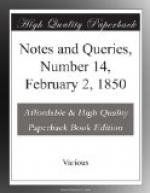SELEUCUS.
Under the Rose.—That the English proverbial expression, Under the Rose, is derived from the confessional, is, I believe, generally admitted: but the authorship of the well-known Latin verses on this subject is still, as far as I am aware, a rexata quaestio, and gives a somewhat different and tantaleau[1] meaning to the adage:—
“Est Rosa flas Veneris, quem, quo
sua furta laterent,
Harpoerati, Matris dona, dicavit
Amor.
Inde rosam mensis hospes suspendit amicis,
Convivae ut sub ca dicta tacenda
sciant.”
Can any of your correspondents obligingly inform me to whom these not inelegant or unclassical lines are to be attributed?
ARCHAEUS.
Wiesbaden, Dec. 15. 1849.
[Footnote 1: See Pindar’s First Olympic Ode.]
Norman Pedigrees.—Can any gentleman inform me where (in what book) may be found the situation of the places from which the companions of William the Norman took their names? Such French names as have De prefixed—in fact, a Gazetteer? Also, where may be found—if such exist—pedigrees of the same worthies?
B.
Dr. Johnson’s library.—I have long wanted to know what became of the library of Dr. Samuel Johnson (of our city), or if he had any considerable collection of books. Perhaps some of your correspondents would answer both these queries. I happen to have a few, some of which were used in compiling his Dictionary, and are full of his marks, with references to the quotations, most of which are to be found in the Dictionary. I have also his own Prayer-Book.
T.G. LOMAX.
Lichfield, Jan. 11. 1850.
Golden Frog.—In the church of Boxstead, in the county of Suffolk, there is a large and very handsome monument of marble, in a niche of which stands, in full proportion, a man in armour, his head bare, with moustaches and a tuft on his chin; in his right hand he holds a truncheon, and by his side is his sword; his armour is garnished with gold studs, and his helmet stands on the ground behind him; from his right ear hangs a gold frog.
This monument was erected in memory of Sir John Poley, of Wrongay, in Norfolk, knight, who died in 1638, at the age of upwards of eighty, having served much abroad under Henry IV. of France, Christian King of Denmark, &c., and in Queen Elizabeth’s service against the Spaniards.
“Illius ante alios cepit cum dextera
Gades
Militis Angliaci, et fulmina sensit Iberis.”
I send you this detail, in hopes that some of your correspondents may be able to explain the ornament in his ear, whether it be the badge of any order, and whether any other instance is known of its use. There is in Boxstead Hall, the seat of the very ancient family of Poley, a portrait of Sir John having the same ornament.
D.




